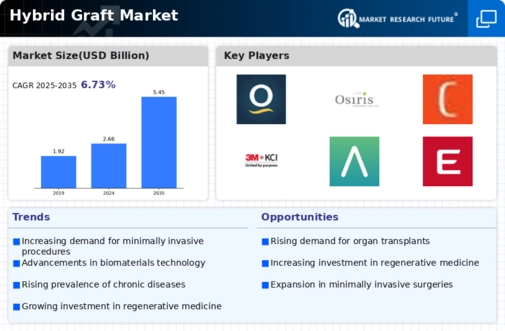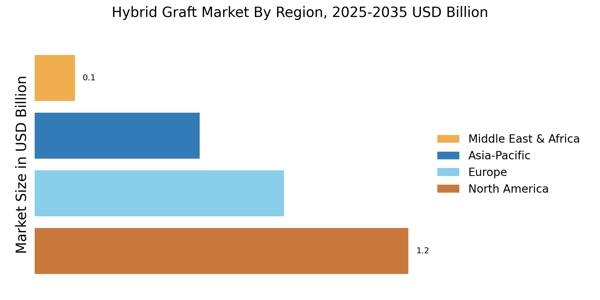Aging Population and Surgical Needs
The aging population is a significant driver for the Hybrid Graft Market. As individuals age, they often face a higher risk of developing conditions that require surgical intervention, such as vascular diseases. This demographic shift is likely to increase the demand for hybrid grafts, which are designed to address complex surgical challenges. Data indicates that the proportion of the population aged 65 and older is steadily increasing, leading to a corresponding rise in surgical procedures. The Hybrid Graft Market is poised to benefit from this trend, as healthcare systems seek effective solutions to meet the surgical needs of an aging population.
Rising Incidence of Chronic Diseases
The Hybrid Graft Market is experiencing growth due to the increasing prevalence of chronic diseases such as cardiovascular disorders and diabetes. These conditions often necessitate surgical interventions, leading to a higher demand for hybrid grafts. According to recent data, the incidence of cardiovascular diseases is projected to rise, which may drive the need for innovative grafting solutions. Hybrid grafts, which combine biological and synthetic materials, offer enhanced performance in these surgical procedures. As healthcare systems adapt to the growing burden of chronic diseases, the Hybrid Graft Market is likely to expand, providing advanced treatment options that improve patient outcomes.
Growing Awareness of Surgical Options
The Hybrid Graft Market benefits from an increasing awareness among patients and healthcare professionals regarding available surgical options. Educational initiatives and improved access to information have empowered patients to seek advanced treatments for their conditions. This heightened awareness is likely to lead to a greater acceptance of hybrid grafts as viable solutions for various surgical needs. As patients become more informed about the benefits of hybrid grafts, including reduced recovery times and improved outcomes, the demand for these products is expected to rise. Consequently, healthcare providers may increasingly incorporate hybrid grafts into their surgical practices, further driving market growth.
Regulatory Support for Advanced Medical Devices
Regulatory bodies are increasingly supportive of innovations in the Hybrid Graft Market. Streamlined approval processes for advanced medical devices have facilitated the introduction of new hybrid graft products. This regulatory environment encourages manufacturers to invest in research and development, leading to a broader range of options for healthcare providers. As regulations evolve to accommodate technological advancements, the market is likely to see an influx of innovative hybrid grafts that meet the needs of diverse patient populations. This supportive regulatory landscape is expected to enhance the growth prospects of the Hybrid Graft Market, fostering competition and innovation.
Technological Innovations in Grafting Techniques
Technological advancements play a pivotal role in the Hybrid Graft Market. Innovations in materials science and surgical techniques have led to the development of more effective hybrid grafts. For instance, the introduction of bioengineered materials that promote better integration with host tissues has transformed surgical practices. The market is witnessing a surge in research and development activities aimed at enhancing graft performance and longevity. As these technologies evolve, they are expected to attract more healthcare providers to adopt hybrid grafts, thereby propelling the market forward. The integration of robotics and minimally invasive techniques further enhances the appeal of hybrid grafts in surgical settings.


















Leave a Comment